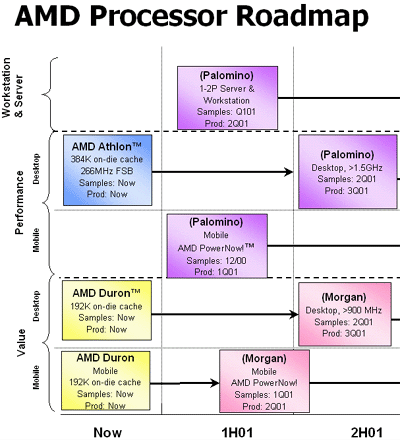An updated Roadmap
As you all have probably already heard as well as noticed, the new Palomino and Morgan cores for the Athlon and Duron respectively are not available. In fact, they won't be available anytime this quarter.
At CeBIT and WinHEC AMD has gone around informing the public of their new, revised roadmap. We provide a look at that below:

Click to see the Full Roadmap through 2002
The first thing to notice is that both Palomino and Morgan, upgraded versions of the Thunderbird core, are going to be out for desktop platforms in the second half of this year.
Interestingly enough, the Palomino core itself will actually make its debut in the mobile and 1-2 processor server/workstation markets in this quarter. This actually makes perfect sense, and it's an approach Intel has been using for a little while now. The MP Server/Workstation market and the mobile market are both much lower volume markets than the performance, mainstream and value desktop market segments. Because of this fact of life, it makes the most sense to introduce a new processor core into these two relatively low-volume segments as it will help to ramp up production and tweak yields, thus preparing the part for a high-volume desktop launch.
The fact that AMD is employing this technique for the launch of the Palomino indicates that the Palomino core is significantly different from the Thunderbird core to the point that such a staggered launch is necessary.
At the same time, the Morgan and Palomino launches appear to be concurrent, or close enough that it can be argued that there won't be any significant differences between those two which is what we already knew from the first time we were introduced to Morgan.
Whatever ends up making its way into the Palomino/Morgan cores should be interesting, since they are still going to be 0.18-micron parts. There is enough out there to believe that AMD would want the Palomino/Morgan to be more than just a cooler running Thunderbird/Spitfire core. It could very well be that in the process of optimizing the current cores for more efficient operation AMD was able to unlock a significant amount of performance that was worthy of delaying the core's introduction until Q3.
Let's hope that is so because by the end of this year, the Pentium 4 will be cheaper, smaller, faster, and have a larger cache; in other words, it will be much more competitive.










0 Comments
View All Comments